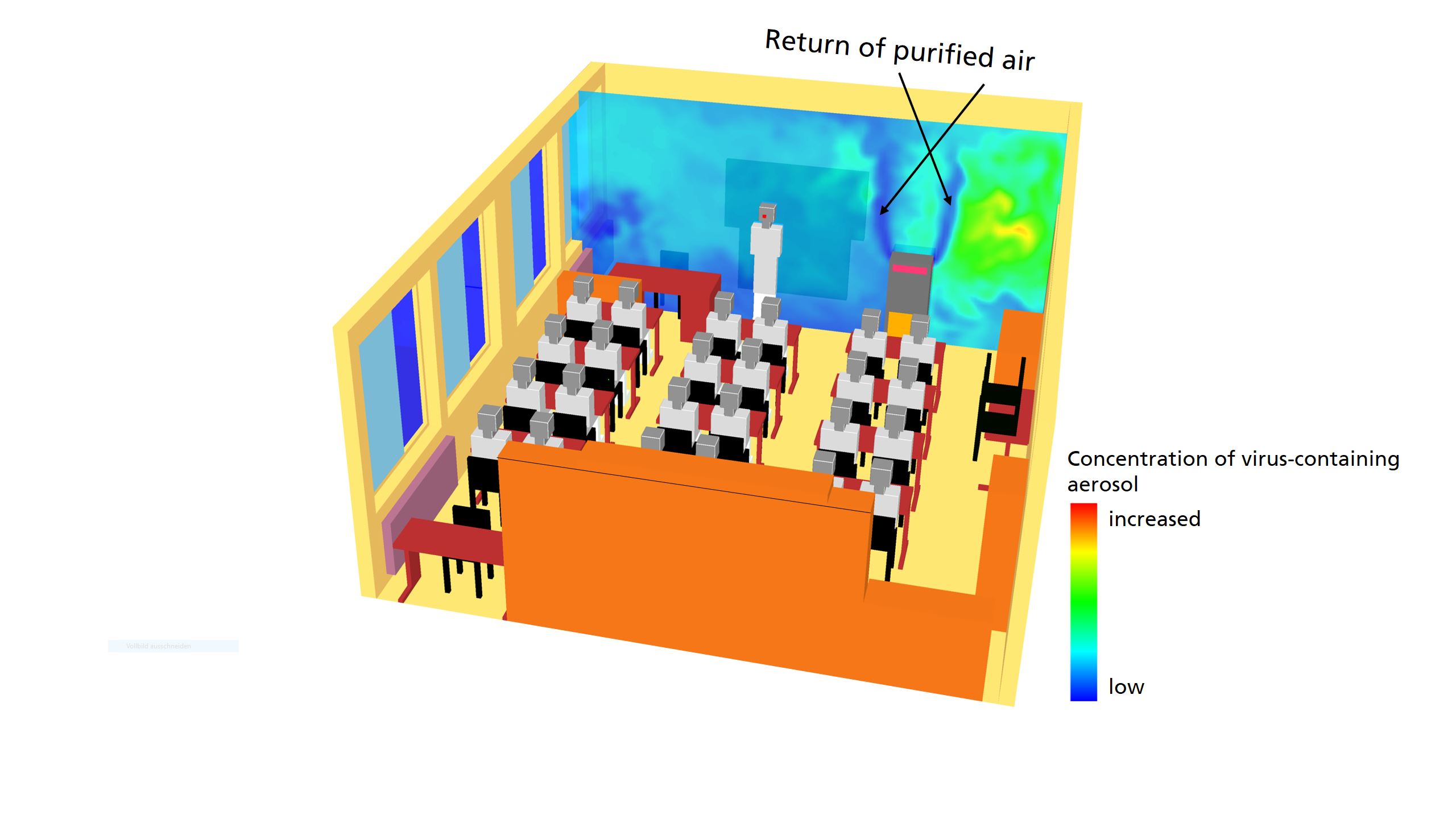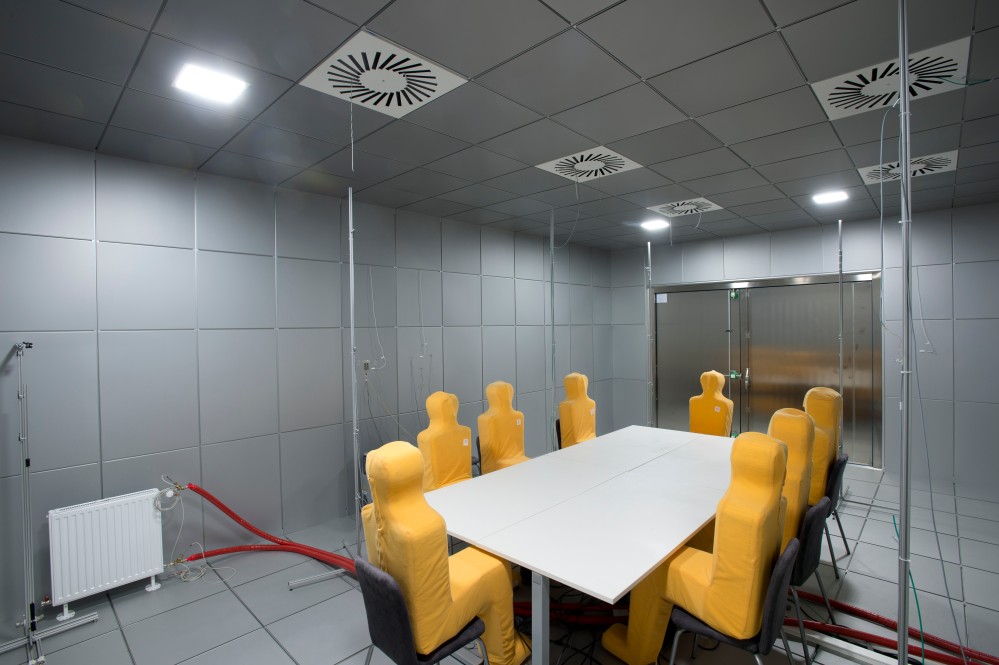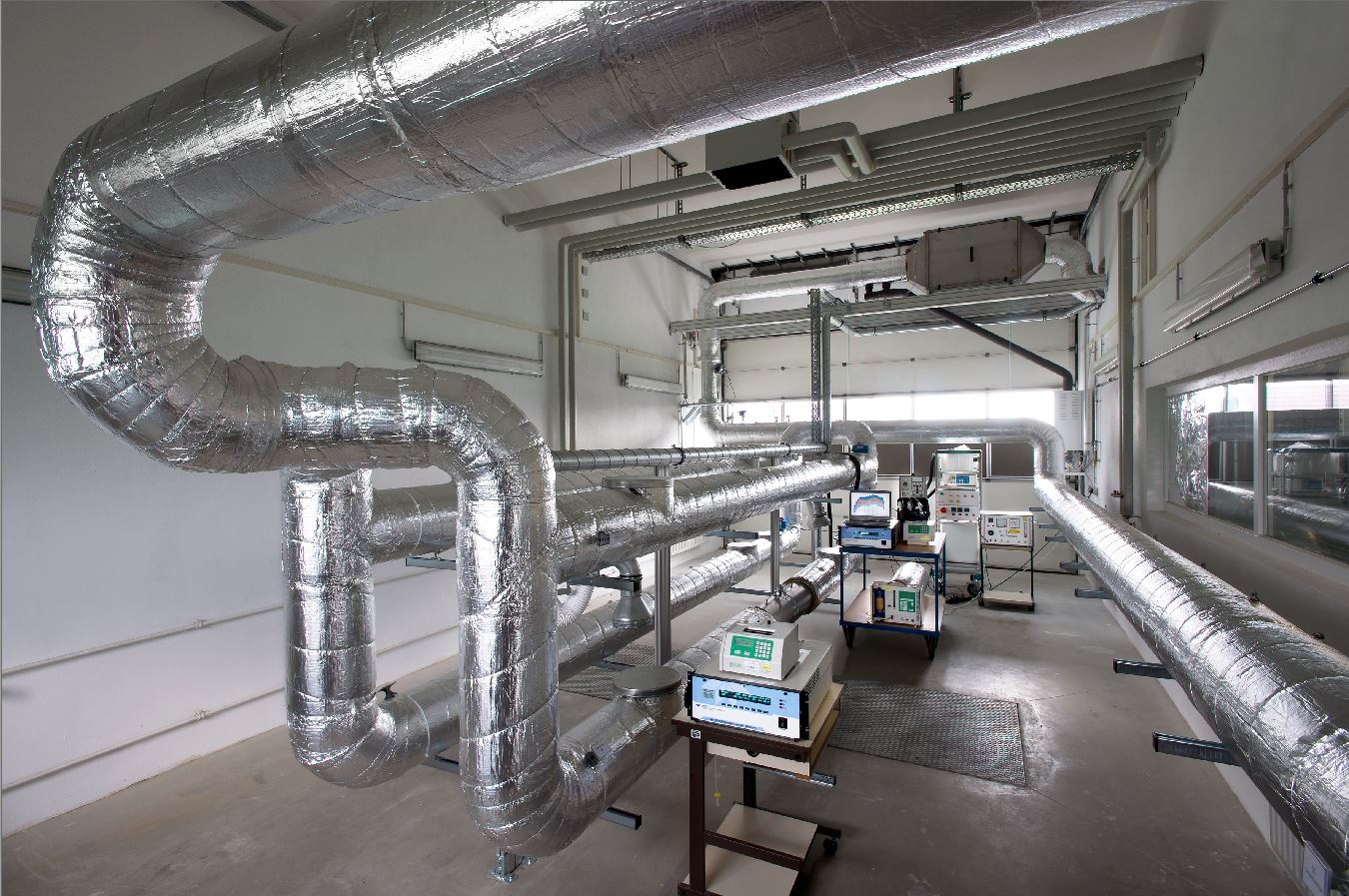Pandemic spread of coronavirus (SARS-CoV-2) can be inhibited by breaking chains of transmission and thereby slowing its spread. Exhaled aerosols represent one of the main transmission routes for infections. In the »AVATOR« project, several Fraunhofer institutes are therefore investigating ways to reduce the risk of infection by aerosol-borne viruses in enclosed spaces. Using the dynamic multiscale simulator developed by our experts, we calculate aerosol propagation in indoor environments.
»AVATOR« – Anti-Virus-Aerosol: Testing, Operation, Reduction
Prediction, Risk Assessment, and Reduction of Aerosol Dispersion for Indoor Environments
SARS-CoV-2 can also be transmitted via droplets or aerosols – airborne droplet nuclei smaller than 10 µm – in normal social interactions. Such transmission is also possible in certain situations over greater distances, for example, when many people congregate in inadequately ventilated indoor spaces and there is increased production and accumulation of aerosols. With this in mind, spacing and fewer people indoors, as well as indoor air hygiene and ventilation, are important components in the pandemic. Especially for educational institutions, hospitals, nursing homes, accommodation and hotel facilities, airplanes or trains and office as well as production facilities we are searching for answers in hygienic questions as well as practical solutions to avoid the spread of aerosol infections.
The Goals of »AVATOR«
In addition to cleaning technologies for indoor air, AVATOR also investigates the dispersion of aerosols and derives hygiene concepts for different applications. We model the dispersion mechanisms in the project using simulations based on »Computational Fluid Dynamics« as well as zonal and agent-based approaches. In parallel to the simulation-based air dispersion assessment methods, the researchers involved are developing various air pollution control technologies. These results will be tested in laboratory environments and validated in real-world environments. The project results will then lead to new concepts for reducing the risk of infection with SARS-CoV-2 in diverse application scenarios.
Solution Path With Three Focal Points
- Dispersion: Simulation of aerosol dispersion and scenario calculation (a.o. our expertise at ITWM).
- Cleaning: Development of different hardware concepts for air purification.
- Validation: Test in real environment and experimental validation of project results
Our ITWM Contribution and Expertise in »AVATOR«
Our experts are developing a dynamic multiscale simulator that calculates aerosol dispersion in indoor environments.
The multiscale approach means that fine details are also included in large-scale long-term observations, such as the type of individual protective equipment. We then derive a risk assessment from the simulation results, which can be used to compare different indoor air concepts for each scenario.
We rely on our competencies and many years of expertise in the following areas:
- Modeling of filtration processes and simulation of filter properties
- Experience in multiscale coupling and fluid dynamic process design
- MESHFREE: Grid-free simulation software for dynamic flow scenarios
What is the Current Status?
Currently, predictions of aerosol dispersion for various indoor application scenarios are being made through various simulations. By involving researchers from micro-, meso- as well as macro-scale simulation, already existing predictions shall be complemented and optimized. By using agent-based simulations, the effects of activities carried out by the people acting in rooms will also be taken into account.
From this, reasonable hygiene measures can be derived and additionally the effectiveness of existing hygiene measures can be validated. Parallel to this – and taking into account the requirements from different room uses - prototypes for various methods of room air purification are being developed.

Video: AVATOR Simulation Scenario Airplane

Privacy warning
With the click on the play button an external video from www.youtube.com is loaded and started. Your data is possible transferred and stored to third party. Do not start the video if you disagree. Find more about the youtube privacy statement under the following link: https://policies.google.com/privacyVideo: AVATOR Simulation Szenario Flugzeug. © Fraunhofer IBP / Fraunhofer ITWM
The scenario considered is based on the aircraft cabin, which can be found in the Fraunhofer IBP flight laboratory. Air and aerosol dispersion within a cabin section are simulated. The grid-free flow solver MESHFREE of Fraunhofer ITWM is used for the simulation. The air flow is significantly influenced by the air conditioning and by the rise of warm breathing air. In the scenario considered, a person (3rd person from the left) emits aerosol droplets. Number and size of emitted aerosols are modeled according to [1]. Compared are 3 scenarios with different mask types: N95 masks, surgical masks, and no masks. The mask efficiency data are based on measurements from [2] and take into account the bypass flow in addition to the pure filter effect.
[1] Pöhlker, Mira L., et al. »Respiratory aerosols and droplets in the transmission of infectious diseases.« arXiv preprint arXiv:2103.01188 (2021).
[2] Grinshpun, Sergey A., et al. »Performance of an N95 filtering facepiece particulate respirator and a surgical mask during human breathing: two pathways for particle penetration.« Journal of occupational and environmental hygiene 6.10 (2009): 593-603.
Video: Simulation of Aerosol Dispersion With Different Protection Types
When we exhale and speak, droplets and aerosols of various sizes are emitted. Larger droplets (red) sink downward. Smaller droplets (yellow, green, blue) initially rise upward, because body heat creates a buoyant flow. Indoors, aerosols do not simply disappear, but spread throughout the room over time. A suitable ventilation or filter concept reduces the aerosol concentration. Different types of protective mouth-and-nose cover prevent dispersion to varying degrees. In the video: Simulations in comparison – a particle-filtering mask (FFP2/N95), a medical face mask (surgical mask), a face visor (Faceshield) and no protection at all.

Privacy warning
With the click on the play button an external video from www.youtube.com is loaded and started. Your data is possible transferred and stored to third party. Do not start the video if you disagree. Find more about the youtube privacy statement under the following link: https://policies.google.com/privacyVideo: Simulation of Aerosol Dispersion With Different Protection Types. © Fraunhofer ITWM
Project Partner:
The project consortium is made up of the following Fraunhofer institutes:
- Fraunhofer Institute for Building Physics IBP
- Fraunhofer Institute for High-Speed Dynamics, Ernst-Mach-Institut, EMI
- Fraunhofer Institute for Chemical Technology
- Fraunhofer Institute for Structural Durability and System Reliability LBF
- Fraunhofer Institute for Applied Polymer Research IAP
- Fraunhofer Institute for Microengineering and Microsystems IMM
- Fraunhofer Institute for Toxicology and Experimental Medicine
- Fraunhofer Institute for Factory Operation and Automation IFF
- Fraunhofer Institute for Physical Measurement Techniques IPM
- Fraunhofer Institute for Computer Graphics Research IGD
- Fraunhofer Singapore
- Fraunhofer Austria
- Fraunhofer Institute for Manufacturing Technology and Advanced Materials IFAM
- Fraunhofer Institute for Interfacial Engineering and Biotechnology IGB
Project Duration and Funding
- Project Duration: October 2020 – September 2021
- This project is part of the program »Fraunhofer versus Corona« of the Fraunhofer-Gesellschaft


